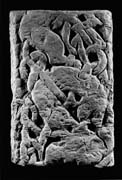Select a site alphabetically from the choices shown in the box below. Alternatively, browse sculptural examples using the Forward/Back buttons.
Chapters for this volume, along with copies of original in-text images, are available here.
Object type: Part of cross-shaft
Measurements: H. 41 cm (16.2 in); W. 28 > 26.3 cm (11 > 10.4 in); D. 13.5 > 12 cm (5.25 > 4.75 in)
Stone type: Very fine-grained, calcareous, white (10YR 8/2) sandstone; probably Middle Calcareous Grit, Coralline Oolite Formation, Middle Oxfordian, Upper Jurassic; perhaps from Stonegrave.
Plate numbers in printed volume: Fig. 7f, 442-445
Corpus volume reference: Vol 3 p. 131
(There may be more views or larger images available for this item. Click on the thumbnail image to view.)
The fragment comes from the middle of a shaft, as the continuing beast-chain testifies.
A (broad): At each side is a cabled edge moulding. It contains a single panel which has substantial parts of two animals of a beast-chain, loosely disposed. The lower one adopts an S-formation, its rump against the right-hand edge moulding, its chest against the left-hand one. The head hangs down over the back. The body has a narrow, contoured outline, which carries on round the semicircular nick where the fetter joins the throat. Within this double outline are four strips of pellets. The oval eye is also contoured. The snout of the beast's head is blunt and the jaws are apart. An ear extension rises from the brow, interlacing with the fetter and the body and limbs. The fore leg is hooked and the paw three-toed. Only the hind leg of the upper beast survives; it resembles a pig's, though the paw is three-toed. The hock is angular and the ham somewhat elongated. A faint trace of double edging remains on the belly. The ear extension from the beast below penetrates the rump through a semicircular nick. The infilling fetter bands are angular and even zig-zag. In the lower left-hand corner of the face the strand is median-incised and forms a loop which is not the free ring of Collingwood's drawing (1911a, fig. b on 258).
B (narrow): Very damaged, except for a fragment of looping strand at the top.
C (broad): Broken away.
D (narrow): The surviving right-hand edge moulding is cabled. Only a little over half of the pattern remains: parts of three registers of what is probably simple pattern F, set vertically, with glides. The strands are median-incised.
The beast-chain of fettered profile animals is common on Anglo-Scandinavian monuments in York and Ryedale (Lang 1978c, 15–16; see Chap. 9). The extended ear and S-shaped disposition, as well as the zoned hatching on the body, was copied on Sutton upon Derwent 1 (Ill. 870), but the beast-chain on Odd's cross at Kirk Braddan on the Isle of Man (Fig. 7j) is similar enough to extend the motif beyond the confines of the Viking Kingdom of York; even the infill of pellets on the body is comparable. The penetration of the bodies by the strands has a parallel in a metal ornament from Kaupang in Norway (Wilson and Klindt-Jensen 1966, pl. XXIIId), though York Minster 3 also has the same trick. Folkton 1 is a provincial copy of competent beast-chains such as the Newgate shaft from York. The linear, ribbon treatment is an Anglo-Scandinavian rendering of animals which are ultimately Mercian and Anglian in origin (see Chap. 9). The varied zoning of the body of those ninth-century models may account for the pelleting here.



